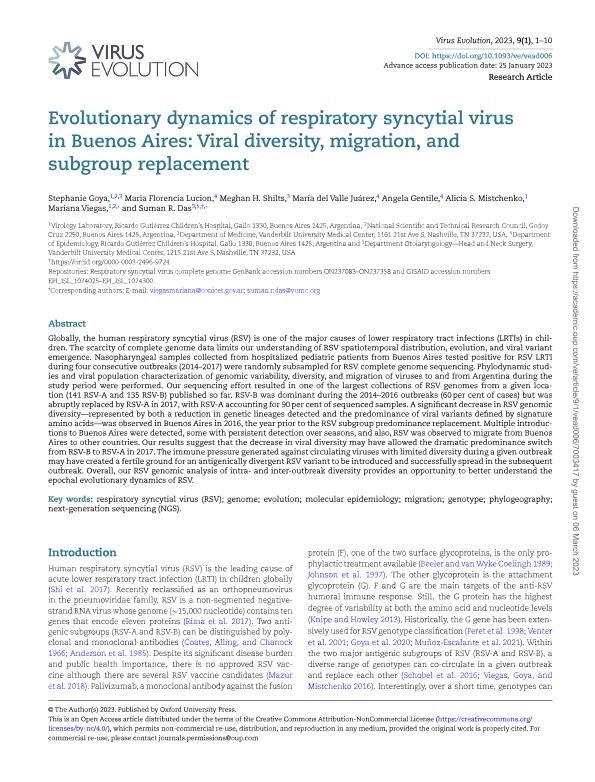Mostrar el registro sencillo del ítem
dc.contributor.author
Goya, Stephanie

dc.contributor.author
Lucion, Maria Florencia

dc.contributor.author
Shilts, Meghan H.
dc.contributor.author
Juarez, Maria del Valle

dc.contributor.author
Gentile, Angela
dc.contributor.author
Mistchenko, Alicia Susana

dc.contributor.author
Viegas, Mariana

dc.contributor.author
Das, Suman R.
dc.date.available
2023-12-04T15:09:21Z
dc.date.issued
2023-01
dc.identifier.citation
Goya, Stephanie; Lucion, Maria Florencia; Shilts, Meghan H.; Juarez, Maria del Valle; Gentile, Angela; et al.; Evolutionary dynamics of respiratory syncytial virus in Buenos Aires: Viral diversity, migration, and subgroup replacement; Oxford University Press; Virus Evolution; 9; 1; 1-2023; 1-10
dc.identifier.issn
2057-1577
dc.identifier.uri
http://hdl.handle.net/11336/219206
dc.description.abstract
Globally, the human respiratory syncytial virus (RSV) is one of the major causes of lower respiratory tract infections (LRTIs) in children. The scarcity of complete genome data limits our understanding of RSV spatiotemporal distribution, evolution, and viral variant emergence. Nasopharyngeal samples collected from hospitalized pediatric patients from Buenos Aires tested positive for RSV LRTI during four consecutive outbreaks (2014-2017) were randomly subsampled for RSV complete genome sequencing. Phylodynamic studies and viral population characterization of genomic variability, diversity, and migration of viruses to and from Argentina during the study period were performed. Our sequencing effort resulted in one of the largest collections of RSV genomes from a given location (141 RSV-A and 135 RSV-B) published so far. RSV-B was dominant during the 2014-2016 outbreaks (60 per cent of cases) but was abruptly replaced by RSV-A in 2017, with RSV-A accounting for 90 per cent of sequenced samples. A significant decrease in RSV genomic diversity - represented by both a reduction in genetic lineages detected and the predominance of viral variants defined by signature amino acids - was observed in Buenos Aires in 2016, the year prior to the RSV subgroup predominance replacement. Multiple introductions to Buenos Aires were detected, some with persistent detection over seasons, and also, RSV was observed to migrate from Buenos Aires to other countries. Our results suggest that the decrease in viral diversity may have allowed the dramatic predominance switch from RSV-B to RSV-A in 2017. The immune pressure generated against circulating viruses with limited diversity during a given outbreak may have created a fertile ground for an antigenically divergent RSV variant to be introduced and successfully spread in the subsequent outbreak. Overall, our RSV genomic analysis of intra- and inter-outbreak diversity provides an opportunity to better understand the epochal evolutionary dynamics of RSV.
dc.format
application/pdf
dc.language.iso
eng
dc.publisher
Oxford University Press

dc.rights
info:eu-repo/semantics/openAccess
dc.rights.uri
https://creativecommons.org/licenses/by-nc-sa/2.5/ar/
dc.subject
EVOLUTION
dc.subject
GENOME
dc.subject
GENOTYPE
dc.subject
MIGRATION
dc.subject
MOLECULAR EPIDEMIOLOGY
dc.subject
NEXT-GENERATION SEQUENCING (NGS)
dc.subject
PHYLOGEOGRAPHY
dc.subject
RESPIRATORY SYNCYTIAL VIRUS (RSV)
dc.subject.classification
Virología

dc.subject.classification
Ciencias Biológicas

dc.subject.classification
CIENCIAS NATURALES Y EXACTAS

dc.title
Evolutionary dynamics of respiratory syncytial virus in Buenos Aires: Viral diversity, migration, and subgroup replacement
dc.type
info:eu-repo/semantics/article
dc.type
info:ar-repo/semantics/artículo
dc.type
info:eu-repo/semantics/publishedVersion
dc.date.updated
2023-12-04T11:38:13Z
dc.journal.volume
9
dc.journal.number
1
dc.journal.pagination
1-10
dc.journal.pais
Reino Unido

dc.description.fil
Fil: Goya, Stephanie. Gobierno de la Ciudad de Buenos Aires. Hospital General de Niños "Ricardo Gutiérrez". Laboratorio de Virología; Argentina. Consejo Nacional de Investigaciones Científicas y Técnicas; Argentina
dc.description.fil
Fil: Lucion, Maria Florencia. Gobierno de la Ciudad de Buenos Aires. Hospital General de Niños "Ricardo Gutiérrez"; Argentina
dc.description.fil
Fil: Shilts, Meghan H.. Vanderbilt University Medical Center; Estados Unidos
dc.description.fil
Fil: Juarez, Maria del Valle. Gobierno de la Ciudad de Buenos Aires. Hospital General de Niños "Ricardo Gutiérrez"; Argentina
dc.description.fil
Fil: Gentile, Angela. Gobierno de la Ciudad de Buenos Aires. Hospital General de Niños "Ricardo Gutiérrez"; Argentina
dc.description.fil
Fil: Mistchenko, Alicia Susana. Gobierno de la Ciudad de Buenos Aires. Hospital General de Niños "Ricardo Gutiérrez". Laboratorio de Virología; Argentina
dc.description.fil
Fil: Viegas, Mariana. Gobierno de la Ciudad de Buenos Aires. Hospital General de Niños "Ricardo Gutiérrez". Laboratorio de Virología; Argentina. Consejo Nacional de Investigaciones Científicas y Técnicas; Argentina
dc.description.fil
Fil: Das, Suman R.. Vanderbilt University Medical Center; Estados Unidos
dc.journal.title
Virus Evolution
dc.relation.alternativeid
info:eu-repo/semantics/altIdentifier/url/https://academic.oup.com/ve/article/doi/10.1093/ve/vead006/7003417
dc.relation.alternativeid
info:eu-repo/semantics/altIdentifier/doi/http://dx.doi.org/10.1093/ve/vead006
Archivos asociados
